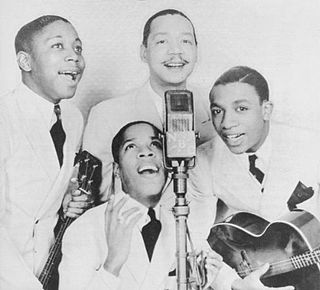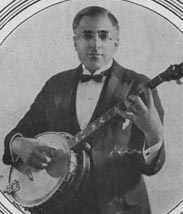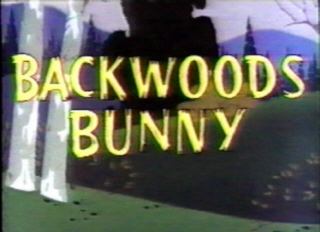History
Written in 1927 by Mort Dixon (lyrics) and Harry M. Woods (music), the song became a success that same year with the release of recordings by Nick Lucas, Ben Bernie, and Jean Goldkette.
The song was then revived during 1948 by several artists, most notably Art Mooney, [1] whose recording topped the charts for three weeks. Other charting 1948 versions were made by Russ Morgan (No. 6), Alvino Rey (No. 6), The Three Suns (No. 10), The Uptown String Band (No. 11), and Arthur Godfrey (No. 14).
During modern times the song is perhaps most associated with Merrie Melodies cartoons, as it was used in several of them, and a common tune played by the string bands in Philadelphia's Mummers Parade. The Sons of Ben, the official supporters' group of Major League Soccer's Philadelphia Union, have adopted the song as one of their chants, singing at every home match at the 20 minute, ten second mark, symbolic as the founding year of the Union.

The Ink Spots were an American pop vocal group who gained international fame in the 1930s and 1940s. Their unique musical style presaged the rhythm and blues and rock and roll musical genres, and the subgenre doo-wop. The Ink Spots were widely accepted in both the white and black communities, largely due to the ballad style introduced to the group by lead singer Bill Kenny.
James Caesar Petrillo was the leader of the American Federation of Musicians, a trade union of professional musicians in the United States and Canada.

Hugh Anthony Cregg III, known professionally as Huey Lewis, is an American singer, songwriter, and actor.

Felice Bryant and Diadorius Boudleaux Bryant were an American husband-and-wife country music and pop songwriting team. They were best known for songs such as "Rocky Top," "We Could", "Love Hurts", and numerous hits by the Everly Brothers, including "All I Have to Do Is Dream", "Bye Bye Love", and "Wake Up Little Susie".

"Another One Rides the Bus" is a 1981 parody of Queen's "Another One Bites the Dust" by American comedy musician "Weird Al" Yankovic. The song describes a person riding in a crowded public bus. It was recorded live on September 14, 1980, on the Dr. Demento Show, hosted by Barret "Dr. Demento" Hansen. Accompanying Yankovic was Jon "Bermuda" Schwartz, who would go on to be the parody artist's long-time drummer.

Little Annie Rooney is a comic strip about a young orphaned girl who traveled about with her dog, Zero.
"Rover" is a song traditionally sung at the end of athletic contest victories by fans of the University of California Los Angeles. It is a parody of the song "I'm Looking Over a Four Leaf Clover". The UCLA Band arrangement opens with "There'll Be a Hot Time in the Old Town Tonight". Following the opening, the band then plays the chorus to "I'm Looking Over a Four Leaf Clover". The band and students sing the lyrics, then the band plays the chorus again.

Carmen Mercedes McRae was an American jazz singer. She is considered one of the most influential jazz vocalists of the 20th century and is remembered for her behind-the-beat phrasing and ironic interpretation of lyrics.

Mort Dixon was an American lyricist.

"They're Coming to Take Me Away, Ha-Haaa!" is a 1966 novelty record written and performed by Jerry Samuels, and released on Warner Bros. Records. The song became an instant success in the United States, peaking at No. 3 on the Billboard Hot 100 popular music singles chart on August 13, No. 1 on the Cash Box Top 100 Pop Singles charts, No. 2 in Canada, and No. 4 on the UK Singles Chart.

John McFee is an American singer, songwriter, guitarist, record producer, and multi-instrumentalist, and long-time member of The Doobie Brothers.

Arthur Joseph Mooney was an American singer and bandleader. His biggest hits were "I'm Looking Over a Four Leaf Clover" and "Baby Face" in 1948 and "Nuttin' For Christmas," with Barry Gordon, in 1955. His fourth million selling song "Honey-Babe" (1955) was used in the motion picture, Battle Cry, having reached the Top 10 in the US.

The Revelers were an American quintet popular in the late 1920s and early 1930s. The Revelers' recordings of "Dinah", "Old Man River", "Valencia", "Baby Face", "Blue Room", "The Birth of the Blues", "When Yuba Plays the Rhumba on the Tuba", and many more, became popular in the United States and then Europe in the late 1920s. In August 1929, they appeared in the Netherlands with Richard Tauber at the Kurhaus, Scheveningen and the Concertgebouw, Amsterdam.

Michael (Mike) Pingitore (1888–1952) was a member of Paul Whiteman's Orchestra. Whiteman discovered him playing tenor banjo and he became part of the rhythm section for his newly-formed band for the Alexandria Hotel in Los Angeles, playing there for its entire existence (1919–1948) except for a brief period in 1923 due to illness. Pingitore played banjo on Art Mooney's "I'm Looking Over a Four Leaf Clover", which was a number one hit on the Billboard magazine pop chart in 1948. He was inducted into the American Banjo Museum Hall of Fame in 2005.
The first season of the Theme Time Radio Hour, hosted by Bob Dylan, ran from May 3, 2006, to April 18, 2007 on XM Satellite Radio for a total of 50 shows.

Just Lookin' for a Hit is the first greatest hits compilation album released by American country music artist Dwight Yoakam. It includes eight singles from his 1980s albums for Reprise Records, as well as two newly recorded cover songs: "Long White Cadillac", originally recorded by The Blasters, and "Sin City", originally recorded by the Flying Burrito Brothers.

Backwoods Bunny is a 1959 Warner Bros. Merrie Melodies cartoon, directed by Robert McKimson and written by Tedd Pierce. The short was released on June 13, 1959, and stars Bugs Bunny. Voiced by Mel Blanc, Bugs Bunny takes a vacation in the Ozarks, but he is pursued by two famished buzzards, voiced by Daws Butler (uncredited.)
Stu David Thomas is an Australian musician, born 1967 in Canberra, raised in Perth, and currently musically active in Melbourne.
"The Best Things in Life Are Free" is a popular song written by the songwriting team of Buddy DeSylva and Lew Brown (lyrics) and Ray Henderson (music) for the 1927 musical Good News. It enjoyed a revival during the period from 1947 to 1950, when it was covered by many artists.

"Too Many Parties and Too Many Pals" is a song released by Hank Williams under the pseudonym Luke the Drifter. The song dates back to at least 1926 when it was recorded by a number of artists including the Bar Harbor Society Orchestra. It had also previously been recorded and released in 1948 by Bill Haley as Bill Haley and the 4 Aces of Western Swing; this was Haley's first professionally released single.















